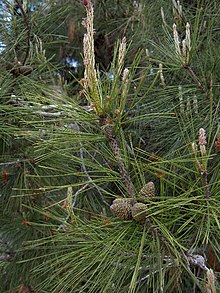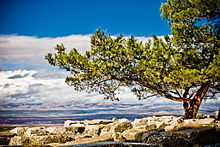| Pinus brutia | |
|---|---|

| |
| Turkish pine foliage and cones | |
| Conservation status | |
 Least Concern (IUCN 3.1) | |
| Scientific classification | |
| Kingdom: | Plantae |
| Clade: | Tracheophytes |
| Clade: | Gymnospermae |
| Division: | Pinophyta |
| Class: | Pinopsida |
| Order: | Pinales |
| Family: | Pinaceae |
| Genus: | Pinus |
| Subgenus: | P. subg. Pinus |
| Section: | P. sect. Pinus |
| Subsection: | Pinus subsect. Pinaster |
| Species: | P. brutia |
| Binomial name | |
| Pinus brutia Ten. | |

| |
| Distribution | |
Pinus brutia, commonly known as the Turkish pine and Calabrian pine, is a species of pine native to the eastern Mediterranean region. The bulk of its range is in Turkey, but certain varieties are naturalized as far east as Afghanistan. It is also known as East Mediterranean pine, Afghan pine, and Brutia pine. The name "Calabrian pine" comes from an introduced grove in the Calabria region of southern Italy; historically this region was called Bruttium, which is likely where the specific epithet "brutia" comes from. Pinus brutia bears many similarities with other, closely related species such as Pinus halepensis and Pinus canariensis. Turkish pine forms a species complex with the former.
Description
Pinus brutia is a medium-size tree, reaching 20–35 metres (66–115 feet) tall with a trunk diameter of up to 1 m (3+1⁄2 ft), exceptionally 2 m (6+1⁄2 ft). The young bark is thin and red-orange, maturing to grey-brown to orange in color, fissured to flaky in texture. The leaves are needle-like, slender, 10–16 centimetres (4–6+1⁄4 inches) long, dark green to yellow-green. The needles come in fascicles of two and rarely three, the latter specimens showing similarities in cone structure to the related Pinus canariensis.
The male cones are squat, 15–20 mm (0.59–0.79 in) long. The female cones are short, with rigid, woody scales, 5–10 cm (2.0–3.9 in) long, 5–7 cm (2.0–2.8 in) broad, maturing from green to red-orange. They most often appear in whorls of 3 to 4, and generally open within two years of fertilization. The seeds are usually wind dispersed, dropping from the cones after they open, but some trees have been observed with cones that do not open enough to facilitate wind dispersal. Frankis believes Krüper's nuthatch assists these trees in dispersal.
-
Mature bark showing red-brown fissures
-
 Mature female cones
Mature female cones
-
 Male (pollen) cones
Male (pollen) cones
-
 Foliage
Foliage
-
 An old specimen from Adana Province, Turkey
An old specimen from Adana Province, Turkey
Varieties
Pinus brutia is closely related to Pinus halepensis, and female P. brutia cones have been shown to accept and hybridize with P. halepensis pollen. In the past it has been considered a variety or subspecies of P. halepensis. The species is now treated as distinct, and forms a species complex across the Mediterranean with P. halepensis.

- Pinus brutia var. brutia: Typical form, with longer needles, 10–18 cm (3.9–7.1 in). Found across Eastern Mediterranean.
- Pinus brutia var. pityusa: Found in smaller stands along the eastern Black Sea coast, near Pitsunda. Very similar to var. brutia.
- Pinus brutia var. pendulifolia: Muğla, Turkey. Exceptionally long needles, 24–29 cm (9.4–11.4 in), that hang in pendules similar to P. canariensis.
- Pinus brutia var. eldarica, Afghan Pine: native to Azerbaijan and Georgia and naturalized in Afghanistan and Pakistan. Smaller cones, 5–8 cm (2.0–3.1 in). Sometimes treated as a subspecies of P. brutia or a species of its own. Due to its tolerance of drought and poor soil, it is widely planted as an ornamental in both southwestern US and Europe.
Taxonomy
Italian botanist Michele Tenore described the species in 1811. While Tenore did not provide an explanation for the specific epithet, Frankis believes Tenore named it after the historical region of Brutium, now Calabria, where an introduced population has become naturalized.
Distribution and habitat

The bulk of its range is in Turkey, but it also extends to southeasternmost Bulgaria, the East Aegean Islands of Aegean Sea, Crete, Crimea, Iran, Georgia, Azerbaijan, northern Iraq, western Syria, Lebanon and Cyprus. It generally occurs at low altitudes, mostly from sea level to 600 m (2,000 ft), up to 1,200 m (3,900 ft) in the south of its range.
Ecology
Pinus brutia is a diagnostic species of the vegetation class Pinetea halepensis.
The Krüper's nuthatch, a rare nuthatch, is largely restricted to forests of Turkish pine and depends heavily on it for feeding; the ranges of the two species are largely coincident.
P. brutia is resistant to the Israeli pine bast scale insect Matsucoccus josephi and is a major host for Thaumetopoea caterpillars.
The species covers 175,000 hectares (430,000 acres) in Cyprus, roughly ~90% of all woodland coverage on the island. It forms ectomycorrhizal associations with numerous species of fungi, and its logs and branches are excellent substrates for many kinds of decomposing organisms.
Uses

Honey
Turkish pine is host to a sap-sucking aphid Marchalina hellenica. Under normal circumstances, this insect does no significant damage to the pine, but is of great importance for the excess sugar it secretes. This sugar, "honeydew", is collected by honey bees which make it into a richly flavoured and valuable honey, "pine honey" (Turkish, çam balı), with reputed medicinal benefits.
Landmark
The "Lone Pine", a prominent landmark tree at an ANZAC First World War battle at Gallipoli, was this species. Cones from the battlefield were taken home to Australia, and plants sourced from the seeds were planted as living memorials.
"Lone Pine" memorials, based on cones brought back from Gallipoli, may use this species or Aleppo pine. Some memorials utilise other species altogether.
Forestry
It is widely planted for timber, both in its native area (it is the most important tree in forestry in Turkey and Cyprus) and elsewhere in the Mediterranean region east to Pakistan. The timber is used for many purposes including carpentry, industry, general constructions, firewood and pulp. In Israel it is sometimes preferred to the wider-used Pinus halepensis (Aleppo pine) because of its resistance to Matsucoccus josephi. It is also known for being well suited to recreational sites.
Cultivation
Pinus brutia is a popular ornamental tree, extensively planted in parks and gardens in hot dry areas (such as southern California, Utah, New Mexico and Nevada, as well as throughout Arizona and central Texas in the United States), where its considerable heat and drought tolerance is highly valued. The subspecies eldarica is the most drought tolerant form, used in Afghanistan, Iran and more recently in the Southwestern United States. In this region, P. brutia subsp. eldarica is referred to as "Eldarica pine", "Afghan pine" or "Mondell pine" (after Mondell Bennett, a commercial tree grower in New Mexico who popularized the species starting in 1969).
References
- Farjon, A. (2013). "Pinus brutia". IUCN Red List of Threatened Species. 2013: e.T42347A2974345. doi:10.2305/IUCN.UK.2013-1.RLTS.T42347A2974345.en. Retrieved 19 November 2021.
- ^ Frankis, Michael (1999). "367. PINUS BRUTIA: Pinaceae". Curtis's Botanical Magazine. 16 (3): 173–184. doi:10.1111/1467-8748.00216. ISSN 1355-4905. JSTOR 45065380.
- ^ Olsson, Sanna; Lorenzo, Zaida; Zabal-Aguirre, Mario; Piotti, Andrea; Vendramin, Giovanni G.; González-Martínez, Santiago C.; Grivet, Delphine (2021-07-01). "Evolutionary history of the mediterranean Pinus halepensis-brutia species complex using gene-resequencing and transcriptomic approaches". Plant Molecular Biology. 106 (4): 367–380. doi:10.1007/s11103-021-01155-7. hdl:10261/288206. ISSN 1573-5028. PMID 33934278.
- ^ "Pinus brutia Ten". The World Flora Online. Retrieved 11 December 2023.
- ^ "Pinus brutia". The Gymnosperm Database. Retrieved 11 December 2023.
- ^ "Pinus brutia - Trees and Shrubs Online". www.treesandshrubsonline.org. Retrieved 2023-12-11.
- "Afghan Pine | Woody Plant Finder | Comprehensive Landscape Plant Directory | Plant Finders | Plant Resources Home | TTU". www.depts.ttu.edu. Retrieved 2023-12-11.
- "Texas A&M Forest Service - Trees of Texas - List of Trees". texastreeid.tamu.edu. Retrieved 2023-12-11.
- "Pinus brutia". Red Book of Bulgaria. Retrieved 10 January 2018.
- "Pinus brutia". Germplasm Resources Information Network. Agricultural Research Service, United States Department of Agriculture. Retrieved 14 April 2011.
- Bonari, Gianmaria; Fernández-González, Federico; Çoban, Süleyman; Monteiro-Henriques, Tiago; Bergmeier, Erwin; Didukh, Yakiv P.; Xystrakis, Fotios; Angiolini, Claudia; Chytrý, Kryštof; Acosta, Alicia T.R.; Agrillo, Emiliano (January 2021). Ewald, Jörg (ed.). "Classification of the Mediterranean lowland to submontane pine forest vegetation". Applied Vegetation Science. 24 (1). Bibcode:2021AppVS..24E2544B. doi:10.1111/avsc.12544. hdl:10400.5/21923. ISSN 1402-2001. S2CID 228839165.
- Loizides, Michael (2021-07-23). "Basidiomycete diversity within Calabrian pine (Pinus brutia) ecosystems on the island of Cyprus". Mycotaxon. 136 (2): 543. doi:10.5248/136.543. S2CID 238789537.
- Wilcox, Mike; Spencer David (May 2007). "Stand up for the real Anzac Lone Pine Of Gallipoli" (PDF). New Zealand Journal of Forestry: 3–9. Retrieved 29 March 2012.
- Fady, B.; Semerci, H. & Vendramin, G.G. (2003). "Aleppo and Brutia pines - Pinus halepensis/Pinus brutia" (PDF). EUFORGEN Technical Guidelines for Genetic Conservation and Use.
- Widmoyer, Fred B. (1984-05-11). "History of Pinus Eldarica in the United States" (PDF). Southwest Christmas Tree Industry Research Needs and Commercial Opportunities: Proceedings of the Symposium held May 11, 1984, Tucson, Arizona. New Mexico State University. Retrieved 5 May 2012.
Further reading
- Shayanmehr, F., Jalali, S. G., Ghanati, F., & Kartoolinejad, D. (2008). Discrimination of Pinus eldarica MEDW. and its two new species by epicuticular wax, lignin content, electrophoretic isozyme and activity of peroxidase. Feddes Repertorium, 119(7‐8), 644–654. http://onlinelibrary.wiley.com/doi/10.1002/fedr.200811188/full
- Shayanmehr, F., Jalali, S. G., Ghanati, F., Kartoolinejad, D., & Apple, M. E. (2009). Two new morphotypes of Pinus eldarica: Discrimination by macromorphological and anatomical traits. Dendrobiology, 61, 27–36. http://onlinelibrary.wiley.com/doi/10.1002/fedr.200811188/full
- Frankis, M. P. (1999). Pinus brutia. Curtis's Botanical Magazine 16: 173–184.
External links
- Photos of trees in Turkey (scroll down page)
- Gymnosperm Database - Pinus brutia
- Conifers Around the World: Pinus brutia – Calabrian pine
- Pinus brutia - distribution map, genetic conservation units and related resources. European Forest Genetic Resources Programme (EUFORGEN)
| Taxon identifiers | |
|---|---|
| Pinus brutia |
|
- IUCN Red List least concern species
- Pinus
- Trees of Western Asia
- Flora of Azerbaijan
- Flora of Bulgaria
- Flora of Georgia (country)
- Flora of Greece
- Trees of Mediterranean climate
- Garden plants of Asia
- Garden plants of Europe
- Drought-tolerant trees
- Ornamental trees
- Natural history of Anatolia
- Flora of the Mediterranean basin